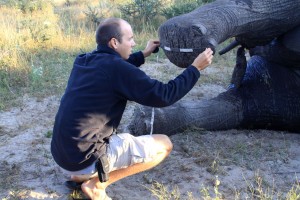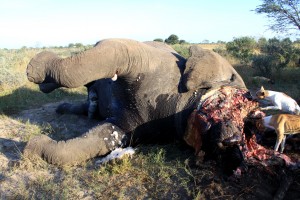The hazards of fieldwork – By James Stevens
April 11, 2014Gus’ first two months in the Makgadikgadi
January 26, 2015What happens when vulnerable species are also pests? By James Stevens
The definition of pest is, “a destructive insect or other animal that attacks crops, food and livestock, etc.” So what happens when this pest is an iconic, vulnerable species? Since the end of February I have been attending fields that have been raided by elephants; to date I have inspected 86 such fields in the two communities Khumaga and Moreomaoto. This figure includes fields that have been raided multiple times, but doesn’t include those where crop-raiding has not been reported by the farmer, or where there have been multiple raids in between the report and the earliest time that I could reach the field.
For this reason I am surprised I have not had to attend more fields like the one I visited today. Yesterday, on returning from Maun to refuel the research vehicle, I was informed by the Department of Wildlife and National Parks (DWNP) Khumaga gate manager that an elephant had been shot dead in a field the afternoon before by a farmer. As my research assistant/translator was away for the Easter weekend the manager kindly offered to take me to the field this morning.
 Feelings often run high when wildlife gets killed, but we have to consider human-wildlife conflict from the human angle as well as the wildlife one. When we arrived at the field, we could see that the farmer had been having trouble with elephants this harvesting season because of the large numbers of old elephant spoor (footprints) throughout the field. We could tell that this farmer was attentive to the crops that he was growing purely to feed his family. The crops had been planted in neat rows, the field had been weeded and we could tell from the height of the crops that he had ploughed his field early. These might be obvious things, but compared to some fields I have seen this was one of the better farmers in the region. He had tried burning chilli pepper, but unfortunately did not have a chilli pepper fence in place and had been raided by elephants continuously. On the afternoon that this particular elephant entered the field, he tried to scare it out of the field by clapping his hands and banging drums, but this caused the elephant to charge at him. Unfortunately, the last resort for this farmer was to shoot the elephant, a legal solution if the elephant is in a farmer’s field.
Feelings often run high when wildlife gets killed, but we have to consider human-wildlife conflict from the human angle as well as the wildlife one. When we arrived at the field, we could see that the farmer had been having trouble with elephants this harvesting season because of the large numbers of old elephant spoor (footprints) throughout the field. We could tell that this farmer was attentive to the crops that he was growing purely to feed his family. The crops had been planted in neat rows, the field had been weeded and we could tell from the height of the crops that he had ploughed his field early. These might be obvious things, but compared to some fields I have seen this was one of the better farmers in the region. He had tried burning chilli pepper, but unfortunately did not have a chilli pepper fence in place and had been raided by elephants continuously. On the afternoon that this particular elephant entered the field, he tried to scare it out of the field by clapping his hands and banging drums, but this caused the elephant to charge at him. Unfortunately, the last resort for this farmer was to shoot the elephant, a legal solution if the elephant is in a farmer’s field.
When I arrived in the field this morning the DWNP officers had removed the elephant’s tusks, some meat had been removed from the body, and scavengers including dogs and were hanging around the carcass. I was able to measure the elephant’s hind foot length to get an estimate of age and can confirm it was a large male at least 36 years old.
With increasing elephant and human populations, this type of conflict is only going to get worse. Most farmers I talk to don’t want to kill wildlife, but as this situation continues, more farmers in the region feel that they are valued less than the local wildlife. They do not see any benefits to the presence of wildlife, so their tolerance of wildlife will reduce and we will start finding more dead elephants, as farmers turn to more and more desperate measures to protect their fields.
 By monitoring the mitigation strategies that farmers are using to keep elephants out of their fields, we can make suggestions regarding what is successful in this region to allow humans and elephants to co-exist. When we visit farmers we teach them about techniques such as burning chilli, using chilli pepper and beehive fences to keep elephants out of their fields and avoid killing problem animals. Hopefully, over the next three years, my project can improve the lives of these farmers while ensuring the protection of the elephants and other wildlife in this region.
By monitoring the mitigation strategies that farmers are using to keep elephants out of their fields, we can make suggestions regarding what is successful in this region to allow humans and elephants to co-exist. When we visit farmers we teach them about techniques such as burning chilli, using chilli pepper and beehive fences to keep elephants out of their fields and avoid killing problem animals. Hopefully, over the next three years, my project can improve the lives of these farmers while ensuring the protection of the elephants and other wildlife in this region.
